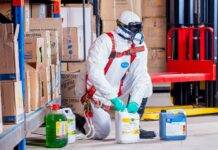
Who Uses COSHH?
Who Uses COSHH? : In the realm of workplace safety and health, the Control of Substances Hazardous to Health (COSHH) regulations stand as a fundamental framework. COSHH isn’t merely a set of guidelines; it’s a crucial tool utilized by diverse industries and sectors, ensuring the protection of employees and the environment from hazardous substances.
I. Introduction to COSHH
The Control of Substances Hazardous to Health, commonly known as COSHH, is a set of regulations designed to manage the risks posed by hazardous substances in the workplace. These substances encompass a wide range, from chemicals and fumes to biological agents and dust.
II. Understanding the Scope of COSHH
A. Importance of COSHH
COSHH holds immense significance in maintaining workplace safety standards. By providing guidelines for handling, storing, and using hazardous materials, it prevents accidents, illnesses, and long-term health issues among employees.
B. Types of Substances Covered
COSHH regulations cover various hazardous substances, including but not limited to chemicals, fumes, dust, biological agents, and nanotechnology-related materials.
III. Who Uses COSHH?
A. Industries and Sectors Applying COSHH
Numerous industries rely on COSHH to protect their workforce, such as manufacturing, healthcare, construction, laboratories, and even office environments where hazardous substances might be present.
B. Responsibilities of Users
Those using or handling hazardous substances are responsible for complying with COSHH regulations. Employers, in particular, must provide adequate training, safety equipment, and implement control measures to ensure compliance.
IV. Benefits of Implementing COSHH
A. Health and Safety Advantages
COSHH implementation results in reduced risks of accidents, occupational illnesses, and long-term health issues. It prioritizes the well-being of employees by minimizing exposure to hazardous materials.
B. Legal and Compliance Aspects
Adhering to COSHH regulations not only safeguards the workforce but also ensures compliance with legal standards, avoiding potential fines, lawsuits, and reputational damage for non-compliance.
V. Challenges in Implementing COSHH
A. Awareness and Education
One of the primary challenges is ensuring adequate awareness and education among employees regarding COSHH regulations and the dangers associated with hazardous substances.
B. Compliance Issues
Some industries face difficulties in consistently complying with COSHH due to the complexity of materials used, evolving regulations, and ensuring ongoing monitoring and evaluation.
VI. Conclusion
The Control of Substances Hazardous to Health (COSHH) is a pivotal set of regulations embraced by various industries, aiming to safeguard employees and the environment from the risks posed by hazardous substances.
Why COSHH is Essential for Workplace Safety
VII. FAQs about COSHH
A. What does COSHH stand for?
COSHH stands for the Control of Substances Hazardous to Health.
B. How does COSHH benefit employees?
COSHH ensures employee safety by managing risks posed by hazardous substances, minimizing exposure, and providing guidelines for safe handling.
C. Are all industries required to follow COSHH regulations?
Most industries that deal with hazardous substances are obligated to adhere to COSHH regulations to ensure workplace safety.
D. Who is responsible for implementing COSHH in a workplace?
Employers are primarily responsible for implementing COSHH regulations and ensuring compliance among employees.
E. Can COSHH regulations change over time?
Yes, COSHH regulations can evolve over time to accommodate advancements in technology, new findings, and emerging hazardous substances.
























